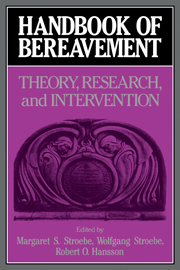Book contents
- Frontmatter
- Contents
- Contributors
- Preface
- Part I Introduction
- Part II The phenomenology and measurement of grief
- Part III Current theories of grief, mourning, and bereavement
- Part IV Physiological changes following bereavement
- 9 Biobehavioral consequences of loss in nonhuman primates: Individual differences
- 10 Neuroendocrine changes following bereavement
- 11 Bereavement, depressive symptoms, and immune function
- Part V The psychological, social, and health impacts of conjugal bereavement
- Part VI Grief reactions to different types of loss
- Part VII Coping, counseling, and therapy
- Part VIII Conclusions
- References
- Author index
- Subject Index
10 - Neuroendocrine changes following bereavement
Published online by Cambridge University Press: 04 May 2010
- Frontmatter
- Contents
- Contributors
- Preface
- Part I Introduction
- Part II The phenomenology and measurement of grief
- Part III Current theories of grief, mourning, and bereavement
- Part IV Physiological changes following bereavement
- 9 Biobehavioral consequences of loss in nonhuman primates: Individual differences
- 10 Neuroendocrine changes following bereavement
- 11 Bereavement, depressive symptoms, and immune function
- Part V The psychological, social, and health impacts of conjugal bereavement
- Part VI Grief reactions to different types of loss
- Part VII Coping, counseling, and therapy
- Part VIII Conclusions
- References
- Author index
- Subject Index
Summary
Normal grief is a process consisting of sadness, longing for the deceased person, somatic complaints, and subsequent recovery. Although the majority of people do not suffer adverse consequences following bereavement, a significant minority experience increased morbidity and mortality. These individuals may be more vulnerable to bereavement, and this vulnerability may be due to some unidentified psychological, neuroendocrine, or immunologic factor that places them at increased risk (Hirsch, Hofer, Holland, & Solomon, 1984).
This chapter focuses on the neuroendocrine changes associated with bereavement, with an emphasis on the psychiatric morbidity following bereavement. The chapter is divided into four sections. The first section briefly summarizes studies of the psychiatric complications of bereavement, and the second section reviews the basic concepts of the neuroendocrine system and stress research in order to facilitate interpretation of neuroendocrine studies. The third section summarizes the neuroendocrine findings in depression and anxiety disorders; both disorders have been found to complicate bereavement. The neuroendocrine abnormalities in these disorders provide clues for neuroendocrine changes that may be associated with complicated bereavement. The fourth section reviews neuroendocrine studies of bereavement.
Psychiatric complications of bereavement
Pathological grief is distinguished from normal grief by the nature, duration, and severity of symptoms. Although the concept of pathological grief has been well described (cf. Middleton, Raphael, Martinek, & Misso, this volume), there is no consensus on the diagnostic criteria of the syndrome. Recent bereavement studies have adopted an atheoretical or nonetiologic model of psychiatric disorders, avoiding conceptual models of pathological grief and focusing on the descriptive quantification of symptoms.
- Type
- Chapter
- Information
- Handbook of BereavementTheory, Research, and Intervention, pp. 143 - 159Publisher: Cambridge University PressPrint publication year: 1993
- 8
- Cited by

